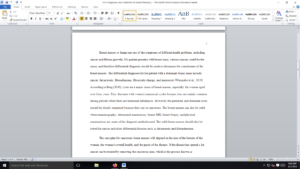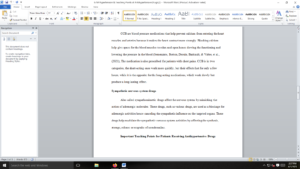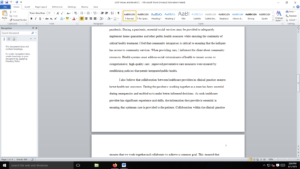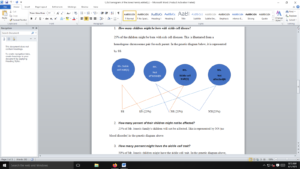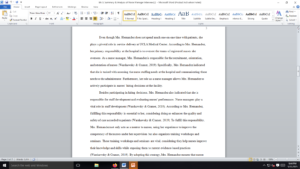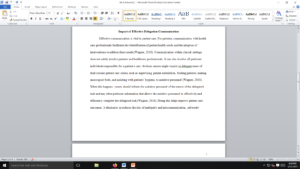For this assessment, you will develop an 8-14 slide PowerPoint presentation with thorough speaker’s notes based on improvement plan you developed in Assessment attached.
As a practicing professional, you are likely to present educational in-services or training to staff pertaining to quality improvement (QI) measures of safety improvement interventions. Such in-services and training sessions should be presented in a creative and innovative manner to hold the audience’s attention and promote knowledge acquisition and skill application that changes practice for the better. The teaching sessions may include a presentation, audience participation via simulation or other interactive strategy, audiovisual media, and participant learning evaluation.
The use of in-services and/or training sessions has positive implications for nursing practice by increasing staff confidence when providing care to specific patient populations. It also allows for a safe and nonthreatening environment where staff nurses can practice their skills prior to a real patient event. Participation in learning sessions fosters a team approach, collaboration, patient safety, and greater patient satisfaction rates in the health care environment (Patel & Wright, 2018).
As you prepare to complete the assessment, consider the impact of in-service training on patient outcomes as well as practice outcomes for staff nurses. Be sure to support your thoughts on the effectiveness of educating and training staff to increase the quality of care provided to patients by examining the literature and established best practices.
Demonstration of Proficiency
By successfully completing this assessment, you will demonstrate your proficiency in the following course competencies and assessment criteria:
- Competency 1: Analyze the elements of a successful quality improvement initiative.
- Explain the need and process to improve safety outcomes related to medication administration.
- Create resources or activities to encourage skill development and process understanding related to a safety improvement initiative on medication administration.
- Competency 4: Explain the nurse’s role in coordinating care to enhance quality and reduce costs.
- List clearly the purpose and goals of an in-service session focusing on safe medication administration for nurses.
- Explain audience’s role in and importance of making the improvement plan focusing on medication administration successful.
- Competency 5: Apply professional, scholarly, evidence-based strategies to communicate in a manner that supports safe and effective patient care.
- Slides are easy to read and error free. Detailed speaker notes are provided. Speaker notes are clear, organized, and professionally presented.
- Organize content with clear purpose or goals and with relevant and evidence-based sources (published within 5 years).
Professional Context
As a baccalaureate-prepared nurse, you will often find yourself in a position to lead and educate other nurses. This colleague-to-colleague education can take many forms, from mentoring to informal explanations on best practices to formal in-service training. In-services are an effective way to train a large group. Preparing to run an in-service may be daunting, as the facilitator must develop his or her message around the topic while designing activities to help the target audience learn and practice. By improving understanding and competence around designing and delivering in-service training, a BSN practitioner can demonstrate leadership and prove him- or herself a valuable resource to others.
Scenario
For this assessment it is suggested you take one of two approaches:
- Build on the work that you have done in your first two assessments and create an agenda and PowerPoint of an educational in-service session that would help a specific staff audience learn, provide feedback, and understand their roles and practice new skills related to your safety improvement plan pertaining to medication administration, or
- Locate a safety improvement plan through an external resource and create an agenda and PowerPoint of an educational in-service session that would help a specific staff audience learn, provide feedback, and understand their roles and practice new skills related to the issues and improvement goals pertaining to medication administration safety.
Instructions
The final deliverable for this assessment will be a PowerPoint presentation with detailed presenter’s notes representing the material you would deliver at an in-service session to raise awareness of your chosen safety improvement initiative focusing on medication administration and to explain the need for it. Additionally, you must educate the audience as to their role and importance to the success of the initiative. This includes providing examples and practice opportunities to test out new ideas or practices related to the safety improvement initiative.
Be sure that your presentation addresses the following, which corresponds to the grading criteria in the scoring guide. Please study the scoring guide carefully so you understand what is needed for a distinguished score.
- List the purpose and goals of an in-service session focusing on safe medication administration for nurses.
- Explain the need for and process to improve safety outcomes related to medication administration.
- Explain to the audience their role and importance of making the improvement plan focusing on medication administration successful.
- Create resources or activities to encourage skill development and process understanding related to a safety improvement initiative on medication administration.
- Communicate with nurses in a respectful and informative way that clearly presents expectations and solicits feedback on communication strategies for future improvement.
There are various ways to structure an in-service session; below is just one example:
- Part 1: Agenda and Outcomes.
- Explain to your audience what they are going to learn or do, and what they are expected to take away.
- Part 2: Safety Improvement Plan.
- Give an overview of the current problem focusing on medication administration, the proposed plan, and what the improvement plan is trying to address.
- Explain why it is important for the organization to address the current situation.
- Part 3: Audience’s Role and Importance.
- Discuss how the staff audience will be expected to help implement and drive the improvement plan.
- Explain why they are critical to the success of the improvement plan focusing on medication administration.
- Describe how their work could benefit from embracing their role in the plan.
- Part 4: New Process and Skills Practice.
- Explain new processes or skills.
- Develop an activity that allows the staff audience to practice and ask questions about these new processes and skills.
- In the notes section of your PowerPoint, brainstorm potential responses to likely questions or concerns.
- Part 5: Soliciting Feedback.
- Describe how you would solicit feedback from the audience on the improvement plan and the in-service.
- Explain how you might integrate this feedback for future improvements.
Remember to account for activity and discussion time.
Additional Requirements
- Presentation length: There is no required length; use just enough slides to address all the necessary elements. Remember to use short, concise bullet points on the slides and expand on your points in the presenter’s notes. If you use 2 or 3 slides to address each of the parts in the above example, your presentation would be at least 10 slides and no more than 15 slides (not including the title, conclusion, or references slides).
- Speaker notes: Speaker notes (located under each slide) should reflect what you would actually say if you were delivering the presentation to an audience. This presentation does NOT require audio or a transcript. Another presenter would be able to use the presentation by following the speaker’s notes.
- APA format: Use APA formatting for in-text citations. Include an APA-formatted reference slide at the end of your presentation.
- Number of references: Cite a minimum of 3 sources of scholarly or professional evidence to support your assertions. Resources should be no more than 5 years old.
Requirements: 8-14
Answer preview
vThe analyzed situation involves administering medication to the wrong patient.
vTwo nurses failed to observe established facility protocols for medication administration in the nursing home.
vThe nurse who signed off on the prescription specifically put the order on the wrong resident’s MAR.
The second nurse failed to check medication orders against the patient’s chart.
[Slide 4 of 11]

Safety improvement plan
